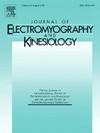Peaks or threshold-crossing: A comparative analysis of neuromuscular jitter measurement methods
IF 2.3
4区 医学
Q3 NEUROSCIENCES
引用次数: 0
Abstract
Introduction
Commercial electromyographic recording systems usually include two different methods for jitter measurement, based on peaks or threshold-crossing. There is reported evidence that the measurements obtained with both methods from discharges recorded with concentric needle electrodes offer comparable results, but this evidence is scarce. This study aimed to replicate such studies and extract conclusions related to the use of the two methods.
Methods
129 EMG recordings were obtained from 12 patients using concentric needle electrodes (0.02 mm2), filtered at 1000 Hz and oversampled to 200 kHz. The recordings were aligned using either peak or threshold-crossing methods. Jitter was measured using both methods and obtained as mean consecutive differences (MCD). Statistical analyses included Anderson-Darling, Wilcoxon, and linear regression tests.
Results
Of the 129 recordings, 49 (38 %) were excluded for presenting contaminated waveforms. MCD values were similar in the two methods, with a median difference of −0.92 µs. The Wilcoxon test confirmed this difference (p = 0.0002). The regression yielded a high coefficient of determination (R2 = 0.994) and a slope of 0.989.
Conclusion
No significant differences were found between the two jitter measurement methods. Variations were only a few µs, not enough to affect pathological jitter diagnosis. Both methods are valid for clinical use.
峰值或阈值交叉:神经肌肉抖动测量方法的比较分析
商业肌电记录系统通常包括两种不同的抖动测量方法,基于峰值或阈值交叉。有报道的证据表明,用两种方法从同心针电极记录的放电中获得的测量结果可提供可比的结果,但这一证据很少。本研究旨在重复此类研究,并提取与使用这两种方法相关的结论。方法采用同心圆针电极(0.02 mm2)采集12例患者的129张肌电图,1000 Hz滤波,200 kHz过采样。使用峰值或阈值交叉方法对记录进行对齐。用两种方法测量抖动,并获得平均连续差(MCD)。统计分析包括安德森-达林检验、Wilcoxon检验和线性回归检验。结果129份记录中,49份(38%)因出现污染波形而被排除。两种方法的MCD值相似,中位差为- 0.92µs。Wilcoxon检验证实了这一差异(p = 0.0002)。回归的决定系数较高(R2 = 0.994),斜率为0.989。结论两种抖动测量方法无显著差异。变化仅为几µs,不足以影响病理性抖动诊断。两种方法均可用于临床。
本文章由计算机程序翻译,如有差异,请以英文原文为准。
求助全文
约1分钟内获得全文
求助全文
来源期刊
CiteScore
4.70
自引率
8.00%
发文量
70
审稿时长
74 days
期刊介绍:
Journal of Electromyography & Kinesiology is the primary source for outstanding original articles on the study of human movement from muscle contraction via its motor units and sensory system to integrated motion through mechanical and electrical detection techniques.
As the official publication of the International Society of Electrophysiology and Kinesiology, the journal is dedicated to publishing the best work in all areas of electromyography and kinesiology, including: control of movement, muscle fatigue, muscle and nerve properties, joint biomechanics and electrical stimulation. Applications in rehabilitation, sports & exercise, motion analysis, ergonomics, alternative & complimentary medicine, measures of human performance and technical articles on electromyographic signal processing are welcome.

 求助内容:
求助内容: 应助结果提醒方式:
应助结果提醒方式:


